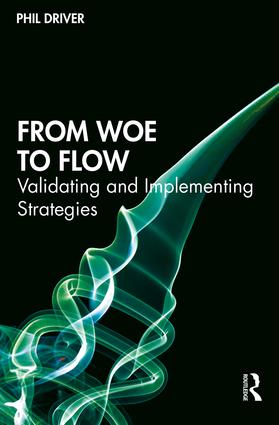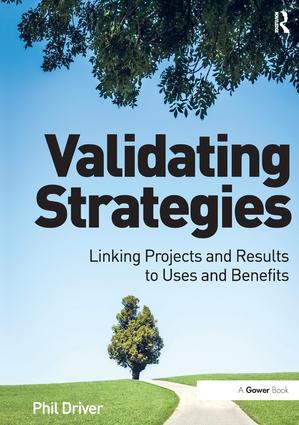Books
 From Woe to Flow – Validating and Implementing Strategies, by Dr Phil Driver
From Woe to Flow – Validating and Implementing Strategies, by Dr Phil Driver
https://www.routledge.com/products/search?keywords=Validating+Strategies
 Validating Strategies – Linking Projects and Results to Uses and Benefits, by Dr Phil Driver
Validating Strategies – Linking Projects and Results to Uses and Benefits, by Dr Phil Driver
https://www.routledge.com/products/search?keywords=Validating+Strategies
Large scale public sector strategies involving dozens of fiercely independent stakeholder organisations require different strategy methodologies from single-organisation strategies. For example they typically require extensive sharing of strategic information via egalitarian, networked systems in which no-one is formally ‘in control’.
Dr Phil Driver’s new practitioners’ guide book From Woe to Flow – Validating and Implementing Strategies shows practitioners how to use the OpenStrategies system to seamlessly develop and refine strategic information, starting with the initial collection of strategic ideas and working through 9 stages including strategy development and validation, contracting, implementation, performance management and strategy review.
So what are the problems that OpenStrategies addresses?
In conversations with thousands of individuals in the public, private and voluntary sectors Phil repeatedly heard their views that less than 20% of strategies have any impact. Why is this?
As detailed in his earlier textbook Validating Strategies – Linking Projects and Results to Uses and Benefits Phil concluded that:
- life is not as simple as “create a strategy then implement it”
- the real world is complex (full of unknown-unknowns as defined by Snowden and Boone – Harvard Business Review Reprint R0711C) and full of uncertainties
- however, strategies and actions must necessarily be simple (known-knowns). This means that you can only implement what you already know you are going to implement, even if there is uncertainty about subsequent effects and impacts
- it can be challenging to translate between the complexity of the real world and the simplicity necessary for effective actions
- complexity includes: multiple stakeholders; multiple agendas; multiple and diverse end-users, suppliers, purchasers and strategic ideas; the need for many different people with diverse skills to simultaneously understand and implement different levels of strategies
The OpenStrategies’ system simultaneously addresses all of the above issues.
This system is based on PRUB-Logic where PRUB represents the universal sequence:
Projects create Results (assets/outputs) that enable and motivate Uses to create Benefits (outcomes)

Figure 1. PRUB-Logic represents the universal sequence of “create assets/outputs and enable and motivate their uses to create outcomes/benefits”
The OpenStrategies system uses PRUB-Logic to define 9 stages that stakeholders need to work through from an initial idea to the successful completion and review of a strategy:
- Stage 1 – Understand Uses and Benefits: engage with end-users to determine what they want to do and why
- Stage 2 – Understand Projects and Results: engage with service suppliers to determine what they can potentially provide to enable and motivate the Uses
- Stage 3 – Develop Evidence-based strategies: Create logical, Evidence-based SubStrategies aligning user requirements with suppliers’ insights
- Stage 4 – Validate SubStrategies by determining their Worth: Determine both their Global Worth and their Motivational Worth (as defined in Chapter 7)
- Stage 5 – Make investment decisions: Compare SubStrategies and select the best ones for investment
- Stage 6 – Develop performance-based contracts: Incorporate Validated SubStrategies and performance indicators and targets into robust contracts
- Stage 7 – Implement strategies with confidence: Follow the PRUB-Logic sequence to implement strategies
- Stage 8 – Performance-manage strategies: Use measurements of indicators to guide the Efficient implementation of current strategies
- Stage 9 – Review and update strategies: Review the Effectiveness of current strategies and update them where appropriate
Strategic information in every stage needs to be clearly explained so everyone can understand it.
Strategic information needs to flow seamlessly between each of these stages.
Different stakeholders are involved in each of the 9 stages so the strategic information needs to flow seamlessly amongst many stakeholders.
Stakeholders often have minimal ‘strategy’ knowledge so strategic information must be presented simply but not simplistically. Strategies must also acknowledge that humans have cognitive limits:
- Millers Law states that humans can hold just 7 +/- 2 ideas in their heads at any one time (https://en.wikipedia.org/wiki/The_Magical_Number_Seven,_Plus_or_Minus_Two)
- Driver’s Law states that humans can cope with just 15+/-5 concepts in diagrammatic form (see Validating Strategies)
So strategies need to be ‘chunked’ into bite-sized units of 15+/-5 concepts so the information can be readily shared and understood. There may be multiple such chunks of information, and multiple layers of chunks of information, but each chunk must contain no more than 15 +/- 5 pieces of information.
Therefore OpenStrategies works with:
the smallest amount of strategic information
that has the highest value
to the most stakeholders.
PRUB-Logic uses and re-uses the same or similar information for 9 separate but seamlessly interlinked stages to enable effective strategy development, delivery and accountability.
From Woe to Flow also demonstrates that being accountable for something is overwhelmingly more important than being accountable to someone. From Woe to Flow also describes how being accountable for something depends on distinguishing between:
- identifying an issue
- prioritising an issue
- contractually specifying what will be done about an issue
- actually doing what is required including performance management of the issue
As was demonstrated in Validating Strategies, only Uses create Benefits – project managers cannot “realise Benefits” – so strategies need to enable and motivate Uses to create those Benefits.
Crucially, ‘Uses’ and ‘users’ are not the same. It is Uses, by users, that create Benefits. Just because there are users does not mean they will undertake the Uses. So From Woe to Flow confirms why it is essential to understand what Uses will actually happen, not just that users exist and have ‘wants’.
Strategies need to be ‘Worth it’ if they are to be implemented. They need to be simultaneously:
- Globally Worth it: the combined value of all the Benefits must be greater than all the costs that will be incurred to enable the Benefits (see the glossary in this book)
- Motivationally Worth it: each stakeholder who needs to contribute to the strategy needs to receive sufficient Benefits to motivate them to make that contribution
While the 9 stages in From Woe to Flow are presented as a start-to-finish sequence, in many situations there will already be strategies being implemented but perhaps not as effectively and efficiently as desired. Therefore stakeholders can start anywhere in the 9 stage process and work backwards and forwards in order to address all the actions in each of the 9 stages: but, crucially, all stages must be addressed.
Chapter 2 of From Woe to Flow re-introduces PRUB-Logic which is explained in more detail in Validating Strategies.
Chapter 3 applies PRUB-Logic to accountability, defining a matrix of accountabilities for effectiveness and efficiency in the context of why being ‘accountable for’ is far more important than being ‘accountable to’. From Woe to Flow also distinguishes between lead indicators of Projects and Results (measures of progress) and lag indicators of Uses and Benefits (measures of success).
Chapters 4 to 12 address each of the 9 stages by: defining them; explaining their importance; clarifying the steps necessary in each stage; demonstrating these steps with evolving examples of SubStrategies based on PRUB-Logic; and confirming efficiency and effectiveness accountabilities.
Chapter 13 summarises From Woe to Flow and provides succinct, strategy-practitioners’ check-lists for each of the 9 stages based on Figure 1 on the next page.
Finally From Woe to Flow’s glossary defines the terms used in the OpenStrategies system.

Figure 2. The 9 Stage OpenStrategies’ system. For clarity this is shown as a linear sequence but in practice is generally iterative.